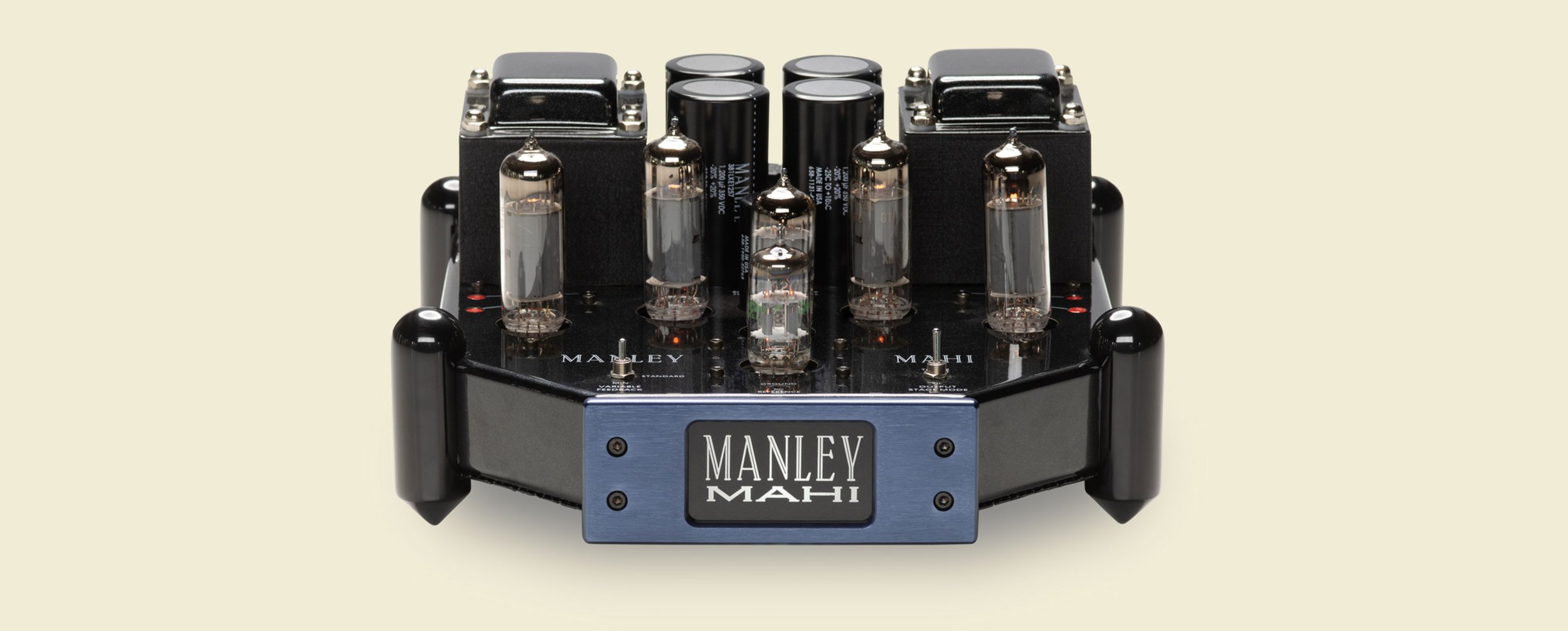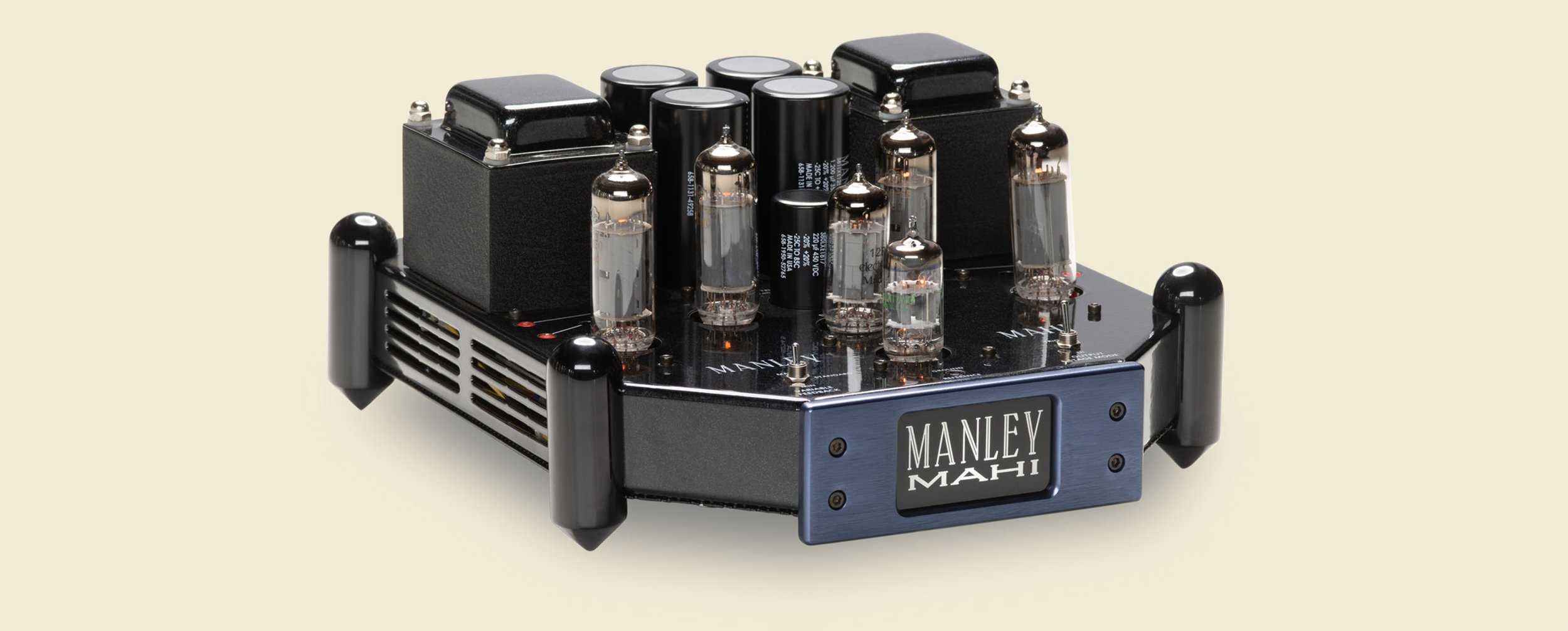
Our longtime love affair with the EL84 has never sounded tighter, faster, or deeper than it does in the MAHI. Larger B+ rail storage means control, impact, and slamming bass punch. Nimble and lively, the MAHI delivers 20 Watts in TRIODE mode and 40 Watts in Ultra-Linear mode through our own custom transformers, engineered and wound at Manley Labs. Variable Feedback switch provides a sonic palette ranging from sweet and seductive to powerful and rockin’. Sold in pairs. (Mahi-Mahi!)
The Manley MAHI monoblocks achieved a Class A rating in the TUBE Amplifier category in STEREOPHILE’s Recommended Components
"The Manley Labs Mahis are easily the best push-pull amps I’ve heard in my system, and I could blissfully listen to them for long periods. They just make listening to music fun, and that's no fish story."
- Vade Forrester, Home Audio Equipment Review, September 2005 -

DETAILS
These cute little guys produce around 40 watts RMS in Ultra-Linear mode or around 20 watts in TRIODE from a quartet of EL84 / 6BQ5 tubes driven by a 12BH7 (or 6414) dual triode driver and a 12AT7EH input dual triode. The EL84 has been one of our very favorite tubes for many years, extremely long lasting and reliable, and can be considered the smaller brother of the much beloved EL34: really quick-sounding both in the bass and especially in the top end. And of course this has a lot to do with our Manley Output transformer, the same one we build for the Manley Stingrays.
We have been building EL84 amplifiers for well over a decade. The Manley-branded Tiny Triodes were much acclaimed in the early 1990's. In 1993 after the Manley company split off from VTL, the Manley Tiny Triodes underwent a chassis rework to become the Manley 35 watt Monoblocks soon followed by the 50 Watt Monoblocks. The more powerful Ultra-Linear mode operation became the standard with hard-wired Triode operation or Triode/UL switching available upon special request.
After the introduction of the Stingray Integrated amplifier in 1998, we then went back and incorporated the Stingray's new circuitry design refinements into the 50 Watt Monoblocks. Finally, big bass out of a small amplifier! So, topology-wise, the post-1998 50 watters were the monoblock version of the stereo Stingray, with the additional variable feedback feature. After the introduction of the fabulous Manley Snappers in 2002, it was obvious that we had to update our classic EL84 50 watt monoblocks both cosmetically and feature-wise. Make-over time!
Everyone was always asking us for Triode/Ultra-Linear switching. We listened to your requests and feature the Triode-UL switch as standardequipment on the MAHI's. As are the beautiful german WBT binding posts. Also we increased the B+ rail capacity in a major way. The 50 Watt monos only had around 45 Joules or energy storage in the B+ rail. Now the MAHI's have nearly 115 Joules of energy storage for the B+ rail. You can hear this improvement in the especially in the bass region: tighter, faster, deeper. More is more in this case.
The chassis design is like a mini-Snapper. They are so cute! And of course they come standard as a pair so you get.... "Mahi-Mahi."
We believe the MANLEY MAHI's give a lot of value for an affordable price and we think you will be surprised at just how big these little guys sound. You have no idea how fabulous these amplifiers are.
SPECIFICATIONS
Input Tube (each mono block): 1 x 12AT7EH large plate Eletcro-Harmonix Russian
Driver Tube (each mono block): 1 x 12BH7EH (or previously 6414)
Output Tubes (each mono block): 4 x EL84 Ships with Russian NOS EL84M (aka 6Pi14Pi-EB)
Output Tube Quiescent Standing Current: 25mA
Set Bias for 250mVDC measured across each 10 Ohm cathode resistor
Input Impedance: 110 kOhm
Negative Feedback: MIN= 3dB; STD=6dB; MAX=10dB of global NFB
Gain:
FB MIN: 30.7 dB TRIODE; 32.1 dB UL
FB STD: 28.5 dB TRIODE; 29.1 dB UL
FB MAX: 26.1 dB TRIODE; 27.1 dB UL
Input Sensitivity for Maximum Output Power, defined as input voltage required in order to produce maximum power output reaching 1.5% THD @ 1KHz:
FB MIN: 175mV TRIODE; 155mV UL
FB STD: 312mV TRIODE; 340mV UL
FB MAX: 480mV TRIODE; 566mV UL
Input Sensitivity for 1W into 8 Ohms: 61mV 53mV
Maximum Output Power, defined as power output reaching 1.5% THD @ 1KHz:
into 5 Ohms:
FB MIN: 18W TRIODE; 20W UL
FB STD: 27W TRIODE; 42W UL
FB MAX: 28W TRIODE; 46W UL
into 8 Ohms:
FB MIN: 14W TRIODE; 24W UL
FB STD: 24W TRIODE; 40W UL
FB MAX: 25W TRIODE; 41W UL
Signal to Noise Ratio Ref. 1W: Typically 82 dB A-WGT 20-20K
Noise Floor: Typically 150µV = -74dBu A-WGT
Noise Floor: Typically 650µV = -62dBu unweighted
Will Scratch Your Floor: Use pennies under pointed feet to avoid marring cabinetry. Try quarters if you are in upper tax brackets. The bargain performer would be nickels. Paper currency does not function as well. Euro coins work 1.54 times better. Concrete pavers or wooden chopping blocks serve fine for amplifier platforms.
Dynamic Range: 83dB
THD+Noise @ 5W: less than 0.15%
Frequency Response at full power UL mode w/MAX NFB: 20 Hz to 20 kHz FLAT
Frequency Response at 5W into 5 Ohms: 10 Hz to 30 kHz FLAT, -3.75dB @ 100KHz
Recommended Speaker Load: Optimized for 5 Ohms
Output Impedance:
FB MIN: 1.22 Ohms TRIODE; 1.35 Ohms UL
FB STD: 0.80 Ohms TRIODE; 0.83 Ohms UL
FB MAX: 0.54 Ohms TRIODE; 0.54 Ohms UL
Damping Factor:
FB MIN: 4.10 TRIODE; 3.70 UL
FB STD: 5.45 TRIODE; 4.78 UL
FB MAX: 9.26 TRIODE; 9.26 UL
Power Consumption (idle): 102 Watts (0.85A @ 120VAC)
Maximum Power Consumption (at Full Power): 168 Watts (1.4A @ 120VAC)
Operating Mains Voltage: Factory set for 100V, 120V or 220-240VAC operation for original destination country's mains voltage.
Operating Mains Voltage: changeable with power transformer re-wiring and fuse value change.
Mains Voltage Frequency: 50 ~ 60 Hz
Fuse type and ratings @ 117 VAC operation:
MAINS fuse: 3 Amp 3AG slow-blow use glass body Littlefuse Series 239Fuse type and ratings @ 230 VAC operation:
MAINS fuse: 1.6 Amp 3AG slow-blow use glass body Littlefuse Series 239B+ Fuse: MDA 400 mA SLO-BLO Ceramic Time-Delay fuse
Badge Illumination: Units produced before 3/2003 use 8V, 0.3A "Fuse-Lamp" 1/4" X 1 1/4" - Serial numbers after MAHI036 use LED illumination which probably won't burn out
Dimensions: 11" deep x 10" wide x 5" tall
Shipping weight each: 18 pounds

REVIEWS
“I didn't even manage to make the little monos noticeably sweat, and I'm not exactly a quiet listener. They play dynamically to the point at all times, deliver an excellently stable room image and always sound convincingly "right" without missing the fun of it. For me, the MAHIs are one of the biggest amplifier discoveries of the past few years…”
- LP Magazine, July 2023 (German)
“The fun, via two toggle switches, is at the front where the Mahi amplifier allows you to voice it for mood, taste, or primarily by choice of speakers.”
“I’ve never used Manley gear that didn’t impress me, and these veterans continue that tradition. Leaving aside the appeal of the Jumbo Shrimp’s no-nonsense approach and Mahi’s exceptional ‘tuneability’ and flexibility, the sound so cosseted the music, and so graced my resident DeVore speakers, that I didn’t want to let go of them.”
“The sense of atmosphere was so all-pervading that it was almost – and I mean this in a good way – a distraction from the performance. How so? Because the Manley pairing was succeeding in achieving that most important of accomplishments in home music reproduction: transporting the listener to the original musical event.”
- Ken Kessler, Hi-Fi News, April 2023
“…the factor that sets them apart from most tube amps I've heard is their refusal to impose a personality, which we might also call an aesthetic, onto the music they reproduce…because of their sonically agnostic nature, the Mahis aced every genre of music I threw at them.”
“This musical breadth and their energetic, approachable, largely faultless sound make the Manley Mahis a pretty compelling proposition at a price that strikes me as entirely sane. If your speakers and room can make a big noise with 40 watts, then these petite but never petite-sounding amplifiers will probably delight you, doing justice to all but the most ambitious systems. They will allow your favorite recordings to excite, inform, and inspire you…”
- Alex Halberstadt, Stereophile, October 2023 (“Brilliant Corners” page 2)
“Especially in Ultralinear mode, with the negative feedback set to minimum, these push-pull EL84 monoblocks from EveAnna Manley succeeded in squeezing maximum dynamics from the La Scalas while imbuing recordings with gorgeous color, pace, and all the detail you might wish for.”
- Alex Halberstadt, Stereophile, March 2023 (within Klipsch La Scala AL5 review)
“…musical and naturally true to the music…there is a fullness and yet proportionately a correctness to the frequency spectrum with the Mahi’s. Highly recommended.”
- Ric Mancuso, Audiophile Audition, November 2021
“It’s all about detail with the Mahis…still one of the most enjoyable pairs of tube amps going. I think I need a pair.”
- Jeff Dorgay, Tone Publications, September 2021
"The Manley MAHI mono blocks are a remarkable achievement...I can thoroughly recommend the Manley MAHI mono blocks to any audiophile."
- Andre Marc, Audio Video Revolution, November 2009
"...the Manley Mahis produce some magical tube sound with the right accessories, and the construction appears to be faultless. They are a well made American product selling at a fair market price."
- Lester J. Mertz, Positive Feedback, May 2006
"The Manley Labs Mahis are easily the best push-pull amps I’ve heard in my system, and I could blissfully listen to them for long periods. They just make listening to music fun, and that's no fish story."
- Vade Forrester, Home Audio Equipment Review, September 2005

OWNER'S MANUAL
FREQUENTLY ASKED QUESTIONS
Why can't I have balanced inputs?
The input stage of this amplifier, and the way the feedback is configured for the amplifier is configured for this single-ended input stage design. The input circuitry uses single-ended topology. In order to be able to provide balanced inputs we would have to convert the signal from balanced using something like some IC's or transformers. Both these options would add more "stuff" to the signal and be certainly audible detracting from the pure sound this amplifier provides. If you are driving this MAHI amplifier from a balanced preamplifier, check to see if you also have unbalanced outputs, change your cables and go with that. You might be pleasantly surprised that they too added extra audible "stuff" in order to provide balanced outputs and the RCAs on your preamp that don't have that extra "stuff" in the signal path actually sound better. (Depends on a given unit's specific design.) Or use some XLR to RCA adaptors. Most balanced gear has no problem driving single ended but check with the manufacturer if they are going to want the negative pin 3 of the XLR grounded or floating. Transformer-coupled XLR jacks always can drive single-ended by running Pin 2 to the HOT middle RCA pin and grounding pin 3 to the RCA outer shell. Some IC coupled XLR outputs will want pin 3 floating, others will require it to be grounded when driving a single-ended input. Check with the manufacturer of your gear to see how to hook it up to a single-ended input.
What tubes should I get for my Manley Mahis?
You can get a complete retube kit right here on our webstore.










